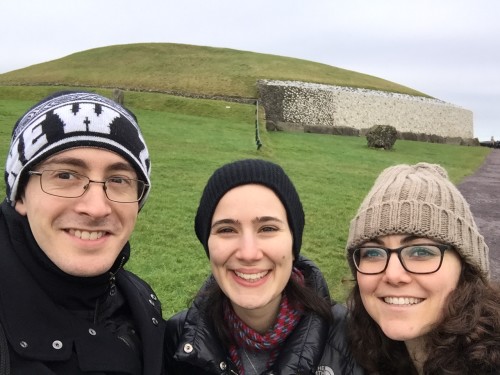Five thousand years ago, Neolithic Irish settlers erected an imposing, circular passage tomb in the hills alongside the River Boyne. And 5000 years later, there it remains: one of the world’s oldest archaeological monuments, just an hour’s bus ride away from the Dublin city center.
The Newgrange monument is a perfect example of a sight I wouldn’t have visited, if not for my fellow Mitchells. I am as indoorsy as they come, and if you find me in the great outdoors chances are I’m only there at the behest of others—in this case, Byron and Megan. But standing in the tomb’s inner chamber, marveling at the ancient engravings and watertight, vaulted ceiling (“Not as drop of rain in 5000 years!” boasted our tour guide) I found myself deeply grateful for having acquiesced to coming along.
The settlers who built Newgrange engineered it not only as a place of burial, but also as a meteorological litmus test, with its precisely situated Roof Box letting light into the chamber only when the sun is at the angle that signals the winter solstice. Our tour guide simulated this effect by switching off the lights (apparently the looseness of the stones from which the tomb is constructed made it easy to install modern lighting), and shining a flashlight along a rectangular path perpendicular to the Roof Box. During the actual winter solstice, spots on the tour are rewarded by lottery. Last year, our tour guide informed us, 32,000 people entered into the drawing for a mere 100 spots.
As soon as I’d entered the chamber, via a cramped passageway that forced even the shortest among us to duck, my emotional state had entered into a tug-of-war between fascination and claustrophobia. Five thousand years of stability notwithstanding, it’s hard to be surrounded on all sides by stone slabs last handled by someone whose birth predated Stonehenge, and not start to fear today will be the day when it all comes crashing down. So, after a couple of minutes of inspecting the interior, Megan and Byron and I exited into the light of day. We spent the rest of our allotted time at the monument strolling alongside its quartz cobblestone exterior—the only part of the monument that is not original, but the result of a reconstructive pioneered by famed archaeologist Michael O’Kelly.
Our journey to the monument had passed quickly, with our tour guide offering historical commentary on the passing landscape, which covered epochs from the Stone Age to the Troubles. Wending our way back toward the city center, the landscape seemed both more vibrant than it had previously—vivified by my new awareness of its history—and quieter in the fading evening light. Hopefully my experience at Newgrange, positive as it was, will push me to be less aggressively indoorsy during the remainder of my time here. As Megan reminded me on the bus, I still haven’t made it to Glendalough!

